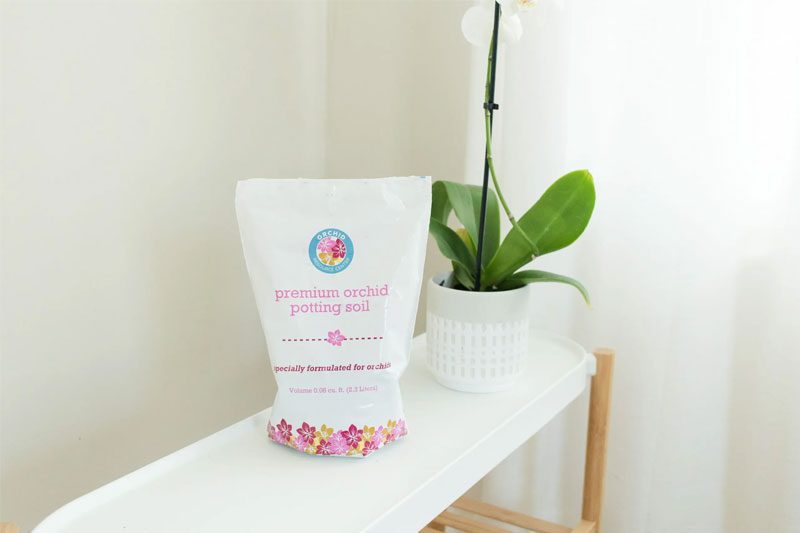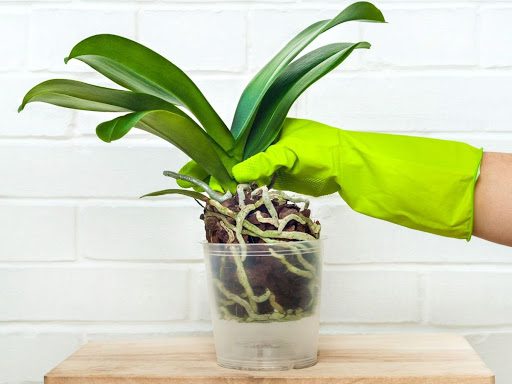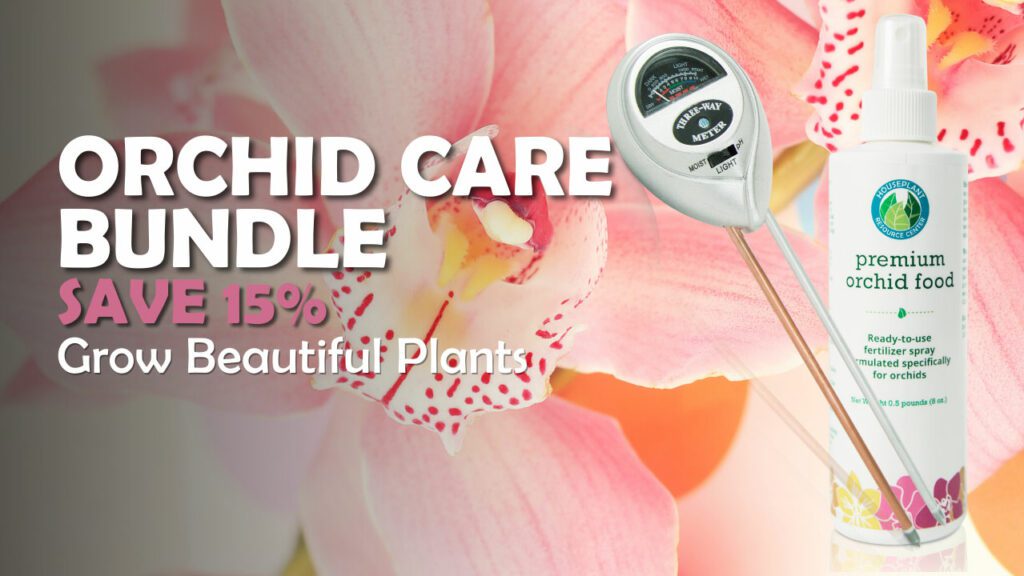Essential Components Of The Best Orchid Soil
When it comes to orchids, the right type of soil isn’t actually soil but rather a unique bark mix that allows for proper drainage and aeration. But what exactly makes up the best orchid soil?
Ensure you’ve got the following essential components in your mix to provide the best growing environment for your orchids.

What Is Orchid Bark Mix
Unlike premium indoor potting soil, orchid bark mix is formulated specifically for the needs of orchids. It comprises various components that replicate their natural growing environment in the wild, where they typically grow on trees or rocks.
While orchid bark mix can vary in composition depending on the species of flower, common ingredients include:
- Bark: Hearty bark is the main component of orchid soil mix. It provides essential drainage and aeration for the roots, preventing root rot and allowing air to reach them.
- Sphagnum moss: Lightweight and highly absorbent, sphagnum moss helps to retain moisture in the soil and provides a conducive environment for root growth.
- Pumice: An amorphous volcanic glass, pumice is a popular addition to orchid bark mix due to its lightweight nature and ability to retain moisture while still allowing for proper aeration.
- High-Quality Peat: This organic material is added to orchid bark mix to help retain moisture and provide a slightly acidic soil pH, which is optimal for most orchids.
- Coco Coir: Similar to sphagnum moss, coco coir is a natural fiber that helps retain moisture and provides a beneficial orchid-growing environment.
- Charcoal: Often made from burnt wood or coconut shells, charcoal helps to absorb excess water and prevent soil compaction in an orchid bark mix.
Some mixes also include or encourage the addition of smart gravel. Made from sterilized, non-toxic, and 100% recycled materials, this gravel helps to provide additional drainage and aeration while promoting the growth of beneficial microorganisms that ensure a healthy root system.

Orchid Bark Mix vs. Potting Soil
Orchid soil prioritizes drainage over moisture retention.
Premium indoor potting soil is great for houseplants that thrive in moist soil conditions, but excess moisture can lead to root rot for orchids. Orchid bark mix is designed to provide proper drainage, preventing water from pooling in the roots and causing damage.
Orchid soil is less dense.
Potting soil is typically more compact and dense than orchid bark mix, allowing for better air circulation in the roots. This is crucial for orchids as they are epiphytes and are used to incredible air circulation around their roots in the wild.
Orchid soil encourages root growth.
The unique composition of orchid bark mix provides the perfect environment for roots to grow and thrive. The open, airy nature of the mix allows for easy root penetration and promotes healthy root development, especially when combined with a liquid root supplement.
Orchid soil prevents nutrient build-up and deficiencies.
Indoor potting soil for houseplants like the monstera, pothos, African violet, or maidenhair fern contains a balanced mix of nutrients to support plant growth. However, these nutrients can build up over time and lead to toxicity in orchids. Orchid bark mix eliminates this issue by providing only the essential components for healthy root growth, allowing you to control the addition of nutrients through fertilizers.
Best Orchid Soil Composition Based On Growing Needs
Cool Spiking Orchids: Moist, airy, and dry before the next watering.
Orchid species such as the Phalaenopsis, Cattleya, and Dendrobium require a mix that benefits their cool spiking needs. When given a potting mix that is constantly moist yet well-drained, these species thrive and don’t retain so much moisture by the next watering cycle that it causes the roots to rot.
Ideal orchid soil compositions for these species lean heavily on pine or fir bark (65%) and include a mix of sphagnum moss, charcoal, and perlite in ratios of 10% to 15%, depending on plant needs.
In addition to the soil composition, these species will need a growing environment that maintains daytime temps around 77°F and nighttime temperatures around 68°F. Keeping these species in low-light environments or at least filtered sunlight is also a good idea.
Summer Blooming Orchids: Evenly moist but not bone dry before the next watering.
Orchid growers cultivating summer blooming species such as the Oncidium, Epidendrum, and Miltonia should use a potting mix that retains some moisture between waterings but is not overly wet.
A mix heavy on fir bark (50%) and including sphagnum moss, coconut husk chips, or charcoal in smaller ratios can provide proper growing conditions for these species. Many orchid lovers have found that adding peat moss (10%) and perlite (10 %) also helps keep these species healthy.
In addition to proper soil composition, these orchids should be moved back from bright windows during summer to prevent leaf burn and ensure adequate moisture retention.
Mud Mix: Always moist so roots never dry out.
Jewels and orchids from the tropics, such as the Masdevallia, Gongora, and Zootrophion, will significantly benefit from being planted in a constantly moist mix. These species thrive when protected from high temperatures and sunlight but kept humid.
The best soil composition for these tropical jewels includes equal parts of organic matter (peat/pumice) and ingredients that absorb water, such as charcoal or coco coir. Additional materials such as orchid bark, sphagnum moss, and perlite can also be added to create a mix that retains moisture while still allowing for proper drainage.
To maintain proper growing conditions for these species, it is important to mist the plant regularly and monitor soil conditions with a moisture meter.
Phragmipedium Mix: Always wet without sacrificing ventilation or aeration.
Phragmipedium orchids, also known as slipper orchids, require a unique mix that is constantly wet without compromising ventilation and aeration. These species come from areas with high humidity levels and need a growing environment that mimics those conditions.
A good soil composition for Phragmipedium orchids includes pumice (50%), hearty bark (25%), and a touch of organic matter such as coconut husk chips or sphagnum moss (10%). This mix should stay consistently wet but not wet to the point where it suffocates the roots.
Fetalization is key to proper growth for these orchids, and incorporating an orchid plant food with a balanced NPK ratio can help provide the necessary nutrients for healthy development.
Paphiopedilum Orchid Mix: Always moist but still airy and well-drained.
Highly sought after for their stunning and unique blooms, Paphiopedilum orchids require a special potting mix that is consistently moist but still provides proper drainage and air circulation for the roots.
A recommended soil composition for these orchids includes bark (60%), perlite or vermiculite (20%), and organic matter such as peat or sphagnum moss (10%). This combination creates a mix that holds moisture and allows for adequate airflow.
These orchids need a combination of low light conditions and moderate temperatures to thrive, making them perfect for growing indoors under artificial lighting. However, mold or fungal growth can be an issue due to this particular growing environment. But you can easily avoid this by regularly cleaning with all-natural leaf shine wipes that discourage mold growth and add an extra layer of protection to vital plant systems.
Should I Buy Orchid Soil or Make It Myself?
The specific needs of your orchid species and your personal growing environment will ultimately determine whether you should buy pre-made orchid soil or mix it yourself. By understanding the unique composition and requirements of different orchids, you can tailor a mix that best suits their needs.
Making your own orchid soil allows for more customization and control over the ingredients used, but it isn’t without its risks. For example, using materials that are too large can cause root damage, while materials that are too small can create a compact mix that hinders drainage and airflow.
Furthermore, there is a massive difference between “wet” and “moist” soil requirements. Some orchids prefer one over the other, and finding the right balance can be tricky. If you accidentally put too much pumice or too little bark, you may create an environment in which your orchid won’t thrive.
Those who buy the best orchid soil have a better chance of keeping their plants happy and healthy. Pre-made mixes are specifically formulated for orchids and take the guesswork out of creating the perfect growing conditions with organic ingredients such as hearty bark mix for healthy aeration, high-quality peat for water retention, and volcanic pumice to ensure strong root systems.
Moreover, pre-made orchid soil optimizes nutrient absorption to promote root growth, flowering, and overall plant health. This can be especially beneficial for beginners or those unfamiliar with their orchid species’ specific needs.
As a bonus, pre-made orchid soil can still be adapted to your orchid’s unique needs. By adding ingredients such as charcoal, perlite, or sphagnum moss, you can adjust the mix and tailor it to your specific orchid without sacrificing the overall quality of the organic, non-toxic soil.
Signs You Need A Better Orchid Mix
Poor Drainage
When you water an orchid, the excess water should be able to drain out through the bottom of the pot. If the soil remains wet for several days after watering, or if your orchid’s leaves start turning yellow, it may be a sign that your mix is not providing proper drainage.
Root Rot
Root rot is common among orchids planted in a mix with poor drainage or components that retain too much moisture. This can be identified by dark or mushy roots, and if left untreated, can lead to the death of the plant. It may be time to switch to a better orchid mix if you notice the common root rot issues, such as wilting leaves, stunted growth, and mushy roots.
Stunted Growth
Orchid roots like to be snug but not suffocated in their potting mix. If you notice that your orchid is not growing at a healthy rate or there is a lack of new leaf and root growth, it may be a sign that the current soil mix is too dense and hinders proper airflow to the roots.
Failure To Bloom
One of the most rewarding aspects of growing orchids is seeing them bloom, but if your plant has yet to produce any flowers, it may be due to inadequate soil composition. Without proper nutrients and aeration, orchids can struggle to reach their full potential and may not produce blooms.
Tips For Repotting With The Best Orchid Soil
Choose the right pot size.
Orchids like a pot that is just snug enough to hold their roots but not too big that it diminishes water absorption or causes soggy soil. When repotting, choose a pot slightly bigger than the previous one with drainage holes at the bottom.
Remove old soil and trim roots if necessary.
After removing your orchid from its original pot, be sure to gently shake out the old soil from the roots. If you notice any rotten or dead roots, trim them off with sharp pruning shears and treat the cut ends with a root supplement to promote healthy regrowth.
Layer new soil in an empty pot and then place the orchid.
Fill the bottom of your new pot with a layer of fresh orchid soil, leaving enough room for the roots to have proper airflow. Then, gently place your orchid on top and carefully fill any gaps with additional soil.
Water thoroughly after repotting.
After repotting, water your orchid until you see water draining out of the bottom of the pot. This will help settle the soil and provide proper hydration for your plant.
Ensure Healthy Growth With The Best Orchid Soil
It is no secret that orchid care requires a lot of attention and specific conditions, especially when it comes to their soil. By choosing the best orchid soil and following proper repotting techniques, you can ensure healthy growth for your orchids and enjoy their beautiful blooms for years to come.
Become part of our Facebook community and share your orchid-growing experiences and tips with fellow enthusiasts. Together, we can help each other create thriving orchid environments and guarantee that our plants receive the best care possible. Happy growing!



